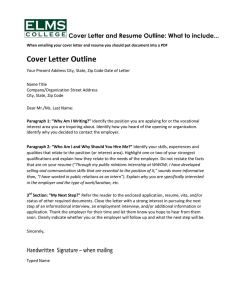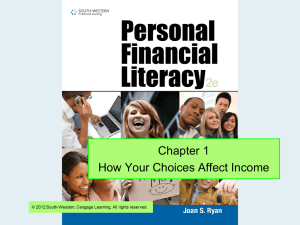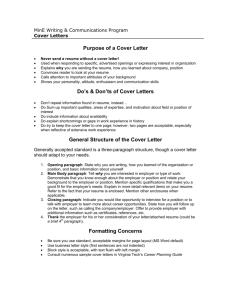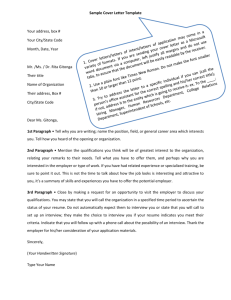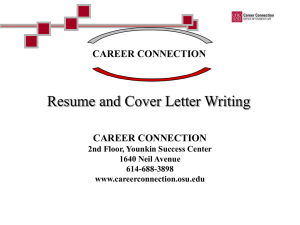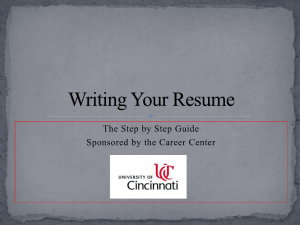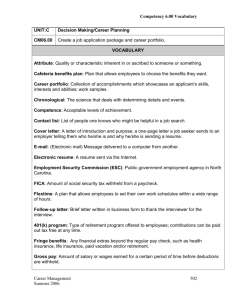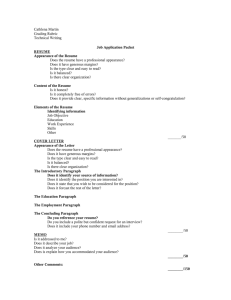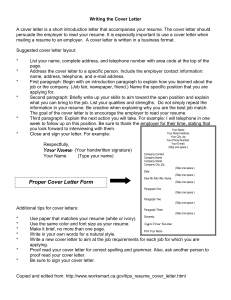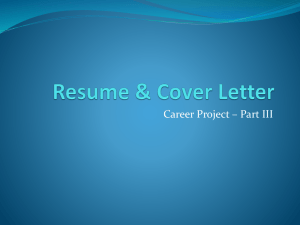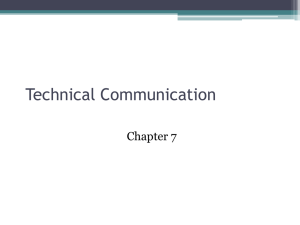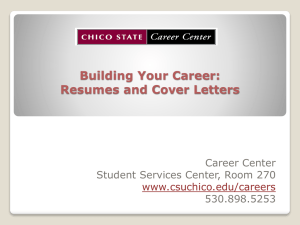Resumes, Cover Letters and Personal Statements
advertisement
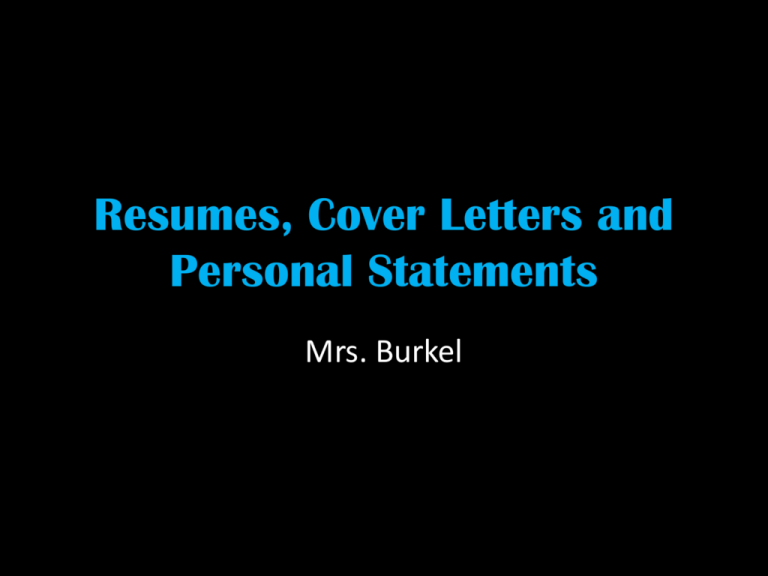
Resumes, Cover Letters and Personal Statements Mrs. Burkel Why are these important? • A resume, a cover letter, and a personal statement are your first impression on a company or school…this is why it needs to be PERFECT • There is a lot of competition, so yours needs to be great Work History or Skills Based? • If you have a job and/or know what you want to do as a career, you will do a Work History resume • If you are unsure still, do a Skills Based resume that deals with building your character Step One: • On a piece of paper, write down five words that describe you • Then, think of specific times in your life that you have lived up to what these words mean • For example, maybe you’re caring b/c you volunteer at shelters. Step Two: • Objective Statement : • What do you want to do? It should be a sentence or two about your employment goals. A customized objective that describes why you are the perfect candidate for the job can help your resume stand out from the competition. Choose one and reword… • Seeking a ________ position with a company which will require me to utilize my skills, abilities and experience in the _______ field to ensure the company's success • To obtain a position in the ______ field where I can utilize my work experience and education to improve company's operation • To obtain a position as a _________ in a ________ company while continuing my education Step Three: • Education: – Grayslake North High School Grayslake, IL • Graduate May 2013 Step Four: • Employment history: begin with the most recent • Skills based: begin with the most recent activities as well Example of Work History… • Summer 2012: Chili’s Bar and Grill Vernon Hills, IL – Hostess • Communicated with staff regarding expectations of restaurant, including hospitality, cleanliness and effectiveness. <-PERIOD Example of Skills Based • You will address your positive qualities and discuss how these come forth in your life. Also, think of clubs, sports, and any other extracurricular activities Step Five: • Skills/Awards/Achievements: – List any significant accomplishments from high school: sports, volunteer services, clubs, activities, babysitting, etc. – What do these skills say about you? If you’re on a team, maybe it helped you show leadership or maybe babysitting made you responsible and mature. – Consider NHS, Honor Roll, etc. as well Step Six: • Technology Skills: – What are you proficient in? Microsoft Word, Power Point, etc. – Languages spoken: fluent in Spanish and English. SECTION TWO: Personal Statements or Cover Letter • You will choose to do one of the following… – A personal statement/college essay OR a cover letter. A cover letter introduces yourself to a company and works as an intro to your resume. Personal Statement/College Essay • You will need to pick a prompt for a college you are considering. • If you cannot find one or one of your colleges doesn’t have one, you will then do a personal statement. Common Prompts: • Option #1. Evaluate a significant experience, achievement, risk you have taken, or ethical dilemma you have faced and its impact on you. • Option #2: Discuss some issue of personal, local, national, or international concern and its importance to you. Prompts continued… • Option #3. Indicate a person who has had a significant influence on you, and describe that influence. • Keep in mind the most common responses and try to not duplicate that. You want to stand out. So, you probably don’t want to say how awesome your mom is…they probably read this a lot. But, you could tell a unique story about your mom. Personal Statements: • A personal statement is your “opportunity to tell us about yourself — your hopes, ambitions, life experiences, inspirations. We encourage you to take your time on this assignment. Be open. Be reflective. Find your individual voice and express it honestly” (University of CA). • It should also reflect what your major or ambitions will be in college and what your accomplishments have been thus far Personal Statement Example #1The Creative Approach: • “As a little girl, I spent my summers at the muumuu (Hawaiian dress) factory. The rusted metal fan mesmerized me as it blew hot air around the factory, stirring up the scraps of bright fabric and bits of thread that littered each sewing machine station. The constant whirring of a dozen machines spitting out ruffles and dresses often lulled me to sleep, and I dozed off instead of keeping to my task of sewing tiny fabric triangles to form a quilt. My mother rarely looked up at me from her machine, though every once in a while she would undo a portion of my stitches and admonish me to be neater” (www.top-law-schools.com) Example #2: The Straight Forward Approach • “My interest in science dates back to my years in high school, where I excelled in physics, chemistry, and math. When I was a senior, I took a first-year calculus course at a local college (such an advanced-level class was not available in high school) and earned an A. It seemed only logical that I pursue a career in electrical engineering” (www.purdue.com) OR, you can choose to do a cover letter… • • • • • • • Top left: Your Contact Information Your Name Your Address Your City, State, Zip Code Your Phone Number Your Email Address • Date Under that… • Hit return a few times and then provide the company’s contact information. • This will obviously change with every job that you apply for • Employer Contact Information • Name • Title • Company • Address Salutation • Dear Mr./Ms. _________________ or To Whom It May Concern, First… • The body of your cover letter lets the employer know what position you are applying for, why the employer should select you for an interview, and how you will followup. Then… • First Paragraph: • The first paragraph of your letter should include information on why you are writing. Mention the position you are applying for. Include the name of a mutual contact, if you have one. Be clear and concise regarding your request. Convince the reader that they should grant the interview or appointment you requested in the first paragraph. Next… • The next section of your cover letter should describe what you have to offer the employer. Make strong connections between your abilities and their needs. Mention specifically how your skills and experience match the job you are applying for. Remember, you are interpreting your resume, not repeating it. Try to support each statement you make with a piece of evidence. Use several shorter paragraphs or bullets rather than one large block of text. Last paragraph… • Final Paragraph: • Conclude your cover letter by thanking the employer for considering you for the position. Include information on how you will follow-up (if you are planning to do so). Closing… Respectfully yours OR Sincerely, Handwritten Signature Typed Signature It should visually look like this…
